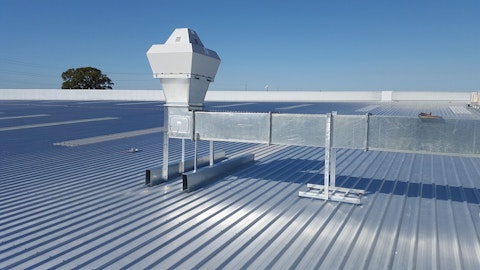SPX Technologies, Inc. (NYSE:SPXC) Q3 2023 Earnings Call Transcript November 5, 2023
Operator: Good day and thank you for standing by. Welcome to the Q3 2023 SPX Technologies Earnings Conference Call. [Operator Instructions] Please be advised that today’s conference is being recorded. I would now like to hand the conference over to your speaker today, Paul Clegg, VP of Investor Relations and Communications. Please go ahead.
Paul Clegg: Thank you and good afternoon, everyone. Thanks for joining us. With me on the call today are Gene Lowe, our President and Chief Executive Officer; and Mark Carano, our Chief Financial Officer. A press release containing our third quarter 2023 results was issued today after market close. You can find the release and our earnings slide presentation, as well as a link to a live webcast of this call, in the Investor Relations section of our website at spx.com. I encourage you to review our disclosure and discussion of GAAP results in the press release and to follow along with the slide presentation during our prepared remarks. A replay of this webcast will be available on our website until November 9. As a reminder, portions of our presentation and comments are forward-looking and subject to Safe Harbor provisions.
Please also note the risk factors in our most recent SEC filings. Our comments today will largely focus on adjusted financial results and comparisons will be the results of continuing operations only. You can find detailed reconciliations of historical adjusted figures from their respective GAAP measures in the appendix to today’s presentation. Our adjusted earnings per share exclude primarily acquisition-related costs, non-service pension items, mark-to-market changes and amortization expense. Finally, we will be conducting meetings with investors over the coming months, including at the Baird Industrials Conference in Chicago and at the UBS Industrial Summit in Palm Beach, Florida, both in November. And with that, I’ll turn the call over to Gene.
Eugene Lowe: Thanks, Paul. Good afternoon, everyone and thank you for joining us. On the call today we’ll provide you with an update on our consolidated and segment results for the third quarter. We’ll also provide an update on our full year guidance for 2023. We achieved strong results in Q3, including significant year-on-year revenue and margin growth and solid performances from our recent acquisitions. During Q3, our businesses executed well and we saw strong demand continue across many of our end markets. Considering our strong year-to-date performance and outlook, we are raising our full year guidance for adjusted EPS by $0.05 at the midpoint, reflecting year-over-year growth of approximately 38%. During the quarter, we finalized an agreement with Mitsubishi to settle all remaining claims between us related to the projects in South Africa.
This is a very positive development which, after many years, brings an end to our involvement in these projects and allows us to further focus on growth. Mark will discuss this in more detail. Overall, I’m pleased with our third quarter performance and continued strong execution on our value creation roadmap. Turning to our high-level results. For the quarter, we grew revenue by approximately 21%, including organic growth of 10.5%, driven by strength in both our HVAC and Detection & Measurement segments. Adjusted operating income grew approximately 57% year-on-year with 390 basis points of margin expansion. With strong backlog, solid order trends and positive operational momentum, we are well-positioned to achieve our updated full year guidance.
As always, I’d like to update you on our value creation efforts. During Q3, we had several successes, including in our digital and sustainability initiatives. On the digital front, we continued to drive value for our customers for the rollout of new software platforms that offer an enhanced functionality. In our fare collection business, we are getting significant customer interest in the newly launched 2.0 version of our Genfare Link platform. This new cloud-based solution enables more efficient use of public transit assets by providing faster and easier data collection and enhanced reporting features. In our locators business, we recently launched Radio detection Manager Online, a cloud-based solution that provides value-added insights such as scan quality and geospatial data.
These help to improve the performance of technicians in the field and further reduce incidents of damage to underground assets. On the sustainability front, our most recent company report reflects significant progress towards our carbon reduction target and notable improvements in water usage. These results validate the process improvements and investments we’ve been making to help drive efficient resource utilization and reduce costs. The report is available on our website. And now, I’ll turn the call over to Mark to review our financial results and guidance.
Mark Carano: Thanks, Gene. It was another strong quarter for SPX Technologies. In Q3, our adjusted EPS grew 31% year-on-year to $1.06. The adjustments from GAAP results covered earlier by Paul are consistent with our historical practice. Total company revenues increased 21.1% year-on-year. HVAC and Detection & Measurement contributed about evenly to organic growth of 10.5%. Acquisitions contributed 10% growth and FX was a modest tailwind. Segment income grew by $28.2 million, or 44.5% to $91.6 million, while segment margin increased 330 basis points. For the quarter in our HVAC segment, revenues grew 27% year-on-year. On an organic basis, revenues grew 10.6%, driven by cooling. Acquisitions contributed growth of 16.3% and included TAMCO in our cooling platform and ASPEQ in our heating platform.

Segment income grew by $25.2 million, or 76%, while segment margin increased 570 basis points. Segment income and margin continued to benefit from strong demand and operational performance in our cooling platform. Our recent acquisitions were accretive to segment margin. Despite strong Q3 deliveries, backlog was virtually unchanged from Q2 at $338 million, reflecting strong orders. For the quarter in Detection & Measurement, revenues grew 11.8% year-on-year. Each of our platforms contributed to organic growth of 10.4%, while currency had a favorable impact of 1.4%. Our project businesses show particular strength, including some earlier-than-anticipated deliveries. Segment income increased by $3 million or 9.9% and margin was similar to the prior year.
Segment backlog at quarter-end was $234 million, or flat with Q2 despite strong deliveries. Overall, we continue to experience a solid environment for project orders. Turning now to our financial position at the end of the quarter. We ended Q3 with cash of $102 million and total debt of $674 million. Our leverage ratio declined to 1.7x from 1.8x in Q2. Year-to-date, adjusted free cash flow was approximately $112 million and we continue to expect full year adjusted free cash flow to be similar to our adjusted net income. During Q3, we finalized an agreement with Mitsubishi to settle all the remaining claims between us related to the legacy South African projects. After many years of successfully reducing the risks associated with these complex projects, this agreement ends our involvement in South Africa and finalizes our repositioning away from legacy power-related businesses as we reprioritize resources to strengthen our focus on the growth of our HVAC and D&M segments.
For the full year 2023, we now expect net cash usage related to South Africa dispute payments of approximately $12 million. This includes a settlement payment in Q3 associated with the agreement, cash awards received during the quarter and a tax benefit. After the settlement payment in the third quarter, we remain in a net positive cash position relative to Mitsubishi on the cumulative awards that were granted by various legal dispute bodies. In 2024, we anticipate one final settlement payment of approximately $19 million, including the related tax benefit. We are very pleased to put this chapter behind us. This agreement removes residual uncertainty related to the dispute resolution process and reflects favorable economics, including the elimination of future legal spending of $15 million to $20 million annually, roughly in line with the remaining settlement payment.
Importantly, we see no impact on our capital deployment capacity and continue to anticipate a net leverage ratio at year-end of 1.5x or lower. Moving on to our guidance. We are increasing our 2023 guidance for adjusted EPS to a range of $4.22 to $4.32 from a prior range of $4.15 to $4.30. The new midpoint of $4.27 reflects a year-on-year growth of 38%. Our HVAC segment guidance remains unchanged. We continue to anticipate segment revenue growth of approximately 24% at the midpoint and segment income margin of approximately 20%. In our Detection & Measurement segment, we now anticipate revenue in a range of $610 million to $620 million, or a year-on-year increase of approximately 12.5% at the midpoint. This compares with the prior range of $590 million to $605 million.
We continue to anticipate segment income margin of approximately 20%. The increase in D&M guidance results largely from stronger project deliveries in the third quarter. As always, you will find modeling considerations in the appendix to our presentation. I’ll now turn the call back over to Gene for a review of our end markets and his closing comments.
Eugene Lowe: Thanks, Mark. Current market conditions remain supportive of our outlook. Within our HVAC segment, we continue to see strong demand for cooling products across a broad set of end market applications, including data centers, semiconductor plants and various other industrial facilities. In heating, commercial and industrial, demand remained solid and channels remain balanced. As anticipated, heating backlog has continued to normalize from last year’s elevated levels. As a result, weather is once again a key factor in influencing the level of demand during the winter months. In Detection & Measurement, our run rate demand is steady with some regional variation, while the environment for project orders remain solid.
In summary, I’m very pleased with our third quarter and year-to-date performance. With a strong backlog and positive operational momentum, we are well-positioned to achieve our updated full year guidance. Looking ahead, I see multiple opportunities to continue investing for growth, including through our active M&A pipeline. I’m also pleased that our settlement agreement in South Africa brings to an end our long involvement there with a favorable economic outcome and the elimination of this risk. I remain very confident in our ability to continue executing on our value creation framework in the near-term for years to come. And with that, I’ll turn the call back to Paul.
Paul Clegg: Thanks, Gene. Operator, we are now ready to go to questions.
Operator: [Operator Instructions] And our first question comes from the line of Bryan Blair with Oppenheimer.
See also 15 Best ARK Stocks To Buy Now and 25 Highest Paying Customer Service Jobs in the US.
Q&A Session
Follow Spx Technologies Inc. (NYSE:SPXC)
Follow Spx Technologies Inc. (NYSE:SPXC)
Bryan Blair: I was hoping you could provide a little more color on the order rates in early Q4 and if there’s any divergence from the underlying trends that were obviously favorable through Q3. And then, it would be great to hear how you’re thinking about demand visibility and growth opportunities into ’24 across SPX [ph].
Eugene Lowe: Yes, Bryan, I’ll take a crack at that. I think, overall, we feel very good about what we’re seeing. If I break it down across our different segments, what I would say is cooling remains very strong. There’s a couple of drivers there. But even across the board, we’re seeing nice strength in our overall cooling business which is really our largest platform. So I think we’re very well-positioned as we look forward into 2024 there. Shifting over to our heating business, our heating business has largely normalized. A lot of that is replacement demand and I think we’re in a more normal situation. So on the Hydronics side, the boiler side, you’re going to see steady growth there every year and the weather of any particular winter can drive demand up or suppress it a little bit.
And then electric heat, we’re seeing solid demand there across the board. So we feel good about what we’re seeing across our HVAC businesses today and actually feel good looking ahead to 2024. If I look on the Detection and Management side, what I would say is we typically think about the projects and the run rate businesses. We’ve had a very strong year on projects. Both over the past 2 years, we’ve done a nice job booking and revenuing a lot of orders but we feel very good on the projects going into 2024. So there’s been a lot of awards and we think we’re very well set up on that side of the equation. And then really, you get to run rate businesses and run rate remains steady. So I think that our markets are holding up. Obviously, we’ve got to keep an eye on the economy and what’s going on there.
But from what we see today, we feel very good about the balance of the year and we feel like it’s still early. We’re still pulling together our planning for ’24 but I would say we’re moving in a positive direction there. Mark, I don’t know if there’s anything else you’d like to add?
Mark Carano: Yes. Thanks, Gene. I would say, Bryan, when I look at the tailwinds and some of the broader drivers across the business that we’ve talked about over the last handful of quarters, I mean they remain solid and positive in many cases. And I think whether it’s some of this federal spending, government spending from the infrastructure bill that’s driving both opportunities in D&M or on the HVAC side, whether it’s reshoring or just general sort of industrial activity, all those trends remain positive today. So we feel good about the backdrop and I don’t think it’s really changed as we sit today.
Eugene Lowe: Yes. And interestingly enough, if you look ahead to ’24, even though we’re really accelerating our shipments this year and having a very good revenue year, we believe we’re going to be nicely up on backlog as we go into ’24. So I think we’re going to be starting in a strong position. So yes, from what we see today in our end markets, we’re feeling positive.
Bryan Blair: Would you be willing to put some numbers to how much data centers and semiconductor plants factor into your confidence on the HVAC side? And what kind of growth has the HVAC segment seen in those verticals in 2023? And what should we expect in ’24?
Eugene Lowe: Yes. I can make a few comments there. We’ve always been in data centers.
Mark Carano: Yes, probably about 10% of this year’s cooling revenue we anticipate would come from data centers. For example, Bryan, that’s up pretty nicely from the prior year. And as you probably have heard us say also, we are seeing an increasing amount of exposure for semiconductor manufacturing and battery plants. And all 3 of those, if you look at those, the customer base there has pretty good visibility into their forward years. So we feel very good about the opportunity there.
Eugene Lowe: Yes. And then the other thing I would say is, even if you strip out those end markets, we’re seeing nice growth across our other end markets. So you take hospitality, institutional, education. Those are nice growth drivers, no doubt and we do feel like there’s some nice forward demand there and that that TAM, that market has expanded. But even in our other segments, we’re seeing nice success there as well. So yes, we feel good about that pride as we look into ’24 and ’25.
Bryan Blair: And last one. Any additional detail you can offer, update on TAMCO and ASPEQ, that would be great. How is integration tracking? How is financial contribution relative to the year 1 deal plans in both cases? And any update on the partial year 2023 accretion? And how should we think about carryover into 2024?
Eugene Lowe: Yes, I’ll start. I think, overall, we’re feeling very good. I’m feeling very good about both of them. The TAMCO one is a little bit more straightforward in the sense that that’s bolting into our EAM business. Those guys have really done a nice job. We’re actually seeing some nice cross-selling there. We’re seeing some data center wins there. So on the TAMCO side, that machine is feeling very good. I really feel like we’ve made a lot of progress there. As we’ve talked about all along, on the ASPEQ side, it is a little bit more complex because you’re bringing 2 scale businesses together. ASPEQ is performing very well. They are, I believe, both of them are ahead of their profit plans and the models that we built for the business but it is a little bit more of a complicated integration there.
We are tracking very well there. We have a very seasoned leader there, Randy Data, who’s overseeing all of the integration processes there. We actually feel really good about the direction of those businesses coming together. But that will take a little bit more time to really fully integrate those; So the upside is very good. Anything else you guys like to add?
Mark Carano: Yes, I would just say that they’re on plan from a financial perspective, Bryan, as we had originally outlined when we made the acquisition. So we feel really good about their financial performance. I believe we indicated earlier this year there’d be about $0.20 of accretion related to those two businesses, net of, obviously, the funding cost and we still hold true to that and believe that will be the case.
Operator: And your next question comes from the line of Lawrence De Maria with William Blair.



